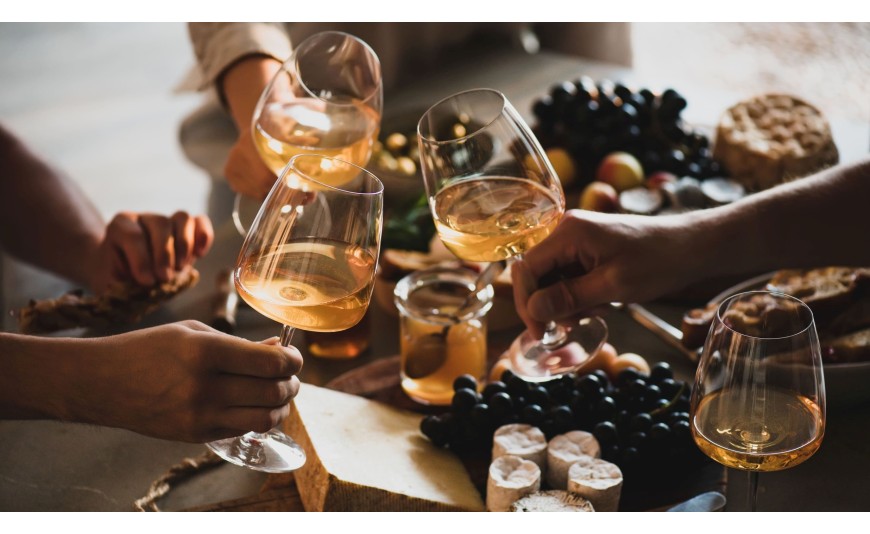Pairing wine with food: 5 simple tips
- 28 Oct, 2021
- Vino

Everything is organized for your dinner: the friends to invite, the menu, the color of the tablecloth to match the candles ... and the wine? How many times has it happened to you to get stuck when choosing the wine to pair with? White or red? Structured or light? Aromatic or fruity? The only solution would be to try the dishes with different wines, but this is not always possible. And there is not even the time to take a course to become a sommelier! Here are our tips!
I assure you that choosing the wine capable of perfectly matching your menu and enhancing its characteristics is easy, you just need to know a few tricks! Here they are revealed in 5 simple steps.
Combination by tradition
Italy has a deeply rooted culinary history, ingredients and recipes strongly linked to the territories. The same is true for combinations: they arise from established habits and are handed down from generation to generation. The recipes, both of the dishes and of the wines, have perhaps changed a bit over time, but it doesn't matter: they should be taken and enjoyed like this: Ribollita and Chianti soup, Risotto with Amarone with Ripasso or Amarone, Abbacchio and Frascati or Cantucci and Holy wine! Would you dare to interrupt a tradition?
Seasonality
It is quite obvious, it is based on the principle that in the various seasons you need different dishes and therefore also the wines must be adapted. In summer, light dishes and fresh whites are preferred, such as a Muller Thurgau or a Ribolla, or ros├® wines. Conversely, in winter, we look for warm, structured and "caloric" dishes, and more full-bodied and complex red wines, such as a Rosso di Toscana.
Concordance
The goal of the combination is to create a harmonious marriage between wine and food, capable of enhancing the characteristics of both and above all balancing them. An important rule: the body of the wine must be proportionate to the structure of the dish and the same goes for the aromas. Here with delicate and simple dishes, steam cooking, light condiments we will try to use wines with contained aromas; elaborate and rich preparations require equally complex and structured wines.
The aromatic complexity of some oriental Curry-based dishes goes well, for example, with the aromaticity of Gewurztraminer; and meats with refined and well-seasoned cooking, need full-bodied red wines, let's think of a classic Brasato which we combine with a Barolo. The principle of concordance is also used for desserts: desserts are only paired with sweet wines! I'm sorry for those who are used to drinking a Spumante Brut with panettone: it's not done!
Contrast
Excluding the case of desserts, the principle of contrast is used. Let's take into consideration the main flavors and sensations of food and see which wine to choose to achieve balance. Here are the most classic combinations:
Fatness: some ingredients have an important fat component and some preparations have substantial seasonings. They therefore need wines with good acidity or effervescence capable of "degreasing". Don't you immediately think of the Zampone and Lambrusco duo?
Sweet trend: preparations like risotto or ingredients like pumpkin have sweet sensations. Wines with good flavor, acidity and possibly effervescence can compensate very well: with pumpkin tortelli a Lambrusco Grasparossa is perfect!
Succulence: that is, the presence of liquids in the mouth, must be balanced with alcohol and tannins that "dry". Let's think of soups or how much salivating grilled meat makes us salivate: Tagliata alla Fiorentina and Chianti! Perfect!
The greasiness given by some condiments and preparations: still alcohol and tannins help us to dilute: roast game, baked meats benefit from full-bodied reds, such as wines from Valtellina or from Aglianico grapes.
Flavor, Bitter Tendency or Acid Tendency, on the other hand, are harsh sensations that require wines with good roundness. Let's see some examples: the brackish flavor of the fish clashes with the tannins and this is why we prefer white wines, with moderate acidity, a Catarratto or a Chardonnay; bitter and acidic sensations, for example of some vegetables, can also be compensated with red wines, as long as they are graceful and round, for example a Chianti Government or a Valpolicella Ripasso.
Difficult matches
Few ingredients or preparations make even the most experienced sommeliers tremble. We must be very careful, because some dishes not only can attack and dominate the wine, but also the sum of the two can be unpleasant. So: if you have a wine that you love and you absolutely do not want to overshadow, pay attention to the following ingredients and preparations, they must be used with care:
Ice creams and ice inhibit the taste buds, and then nothing is perceived.
Vinegar, citrus fruits, marinades: we avoid wines that are too acidic or tannic.
Very bitter chocolate: an alcoholic or fortified wine could help, but beware of tannins if it is a red wine
Artichokes: how much astringency! But in the Roman culinary tradition, artichokes have always found excellent combinations with Lazio white wines
Finally, remember that the rules are useful but the combination is also subjective in the end. The tastes, the sensory abilities of each person, the experiences, the associations that our memory leads us to make are different .. let's start with some principles, but then let us be guided by our senses and our very personal taste!
Try our wines with your kitchen and create magical combinations!
Source: vinicum.com








